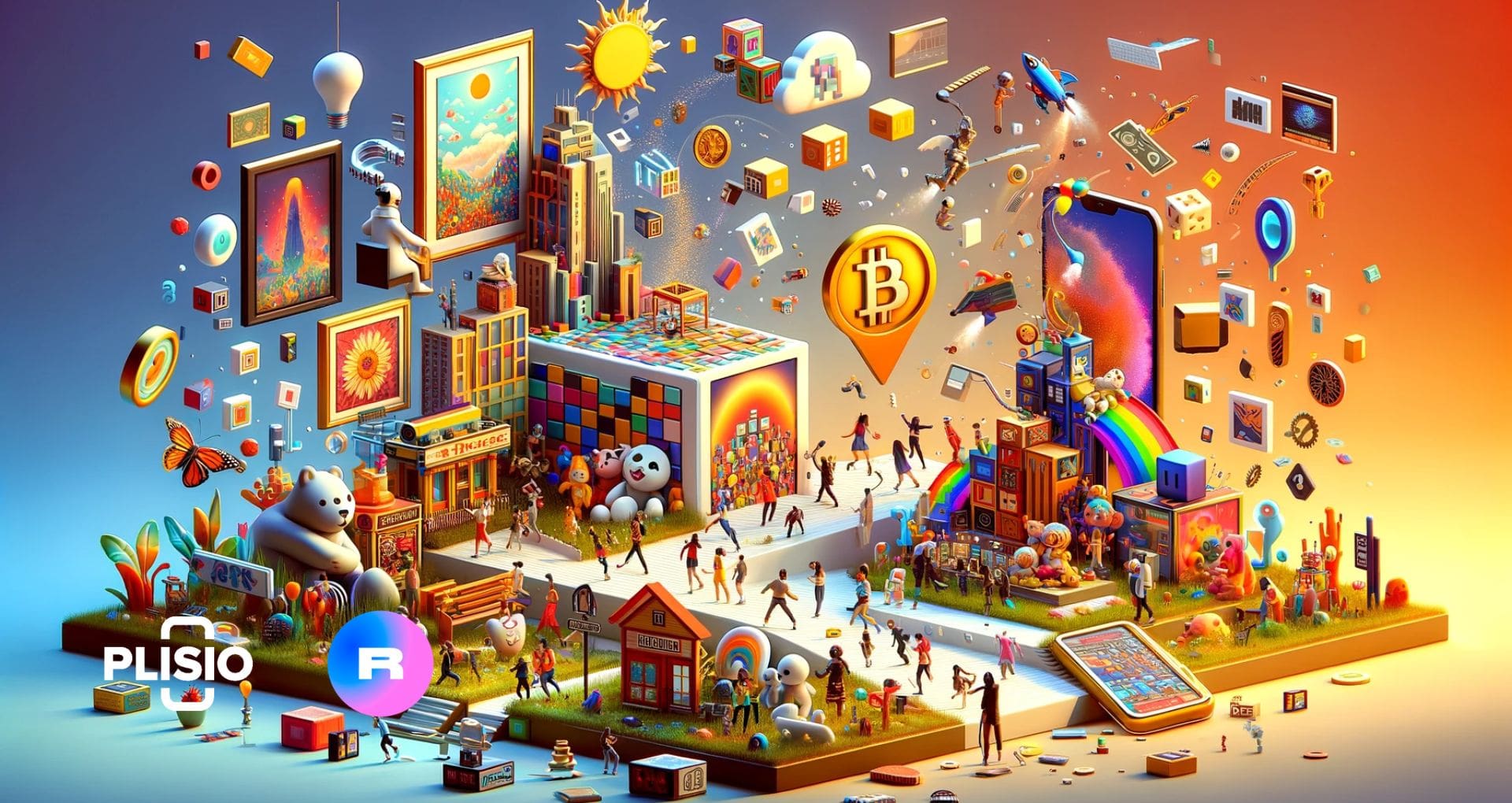Rarible (RARI) NFT Marketplace: How To Use It

Parallel to the rise of cryptocurrencies, Non-Fungible Tokens (NFTs) have also gained prominence. These digital assets, created by users, are traded on digital marketplaces in exchange for cryptocurrency or royalties. A pivotal platform in this burgeoning NFT marketplace is Rarible. Launched in 2019 and headquartered in Los Angeles, Rarible has become a key player in the industry. It functions not only as a platform for trading NFTs but also as a digital art gallery where collectors can showcase and sell their pieces.
What is Rarible
Rarible, a multi-chain NFT marketplace based on the Ethereum blockchain, is revolutionizing the digital art and asset world. This platform allows digital artists and creators to issue and sell unique crypto assets, known as non-fungible tokens (NFTs), which represent ownership of their digital work. Each NFT on Rarible is unique and non-interchangeable, making them fundamentally different from interchangeable cryptocurrencies like Bitcoin.
As a hub for digital innovation, Rarible has become more than just a marketplace; it's a distributed network enabling direct trade without intermediaries. This aspect is crucial in maintaining the ethos of decentralization in the blockchain space. The platform supports various blockchains, including Ethereum, Polygon, Solana, Immutable X, and Flow, widening its accessibility and utility.
Rarible's growth has been impressive, reaching over 2 million active users monthly by 2021 and continuing to expand. Its user-friendly interface allows for easy navigation and creation of NFTs, making it an ideal platform for both seasoned and new creators. The 'Create' tab on the website simplifies the minting process, allowing artists to launch their NFTs on any supported blockchain within the Rarible ecosystem.
Central to Rarible's operation is RARI, its native governance token. Launched in July 2020, RARI has seen a significant increase in value and is unique because it cannot be purchased; it must be earned through participation in the platform's NFT trade. Holding RARI tokens gives users voting rights on platform proposals and the ability to moderate and curate content.
Moreover, Rarible's flexible approach to creator royalties, allowing up to 10% and customizable distributions, demonstrates its commitment to supporting creators' rights and earnings. Beyond digital artworks, memes, and virtual land, the platform has embraced a diverse range of NFTs, including games, music, and photography.
Founded by crypto entrepreneurs Alexander Salnikov and Alexei Falin, Rarible has secured funding from prominent venture capital firms, highlighting its potential and the growing interest in the NFT space. The platform reflects the dynamic and evolving world of Web3 and NFTs, characterized by a blend of sarcasm, memes, and innovative storytelling.
Rarible Features
Rarible, an Ethereum-based NFT marketplace, is an innovative platform linking creators, such as digital artists and meme makers, with buyers interested in unique digital assets. To engage with Rarible, users first require an Ethereum wallet (like Metamask) and some ether (ETH), which can be acquired via an exchange or directly on Rarible using a credit card.
The platform simplifies the process of creating and trading NFTs. Creators begin by "minting" their work into an NFT. This involves filling out a form on Rarible's website, attaching images or data, and setting a price. Once completed, the platform interacts with the Ethereum blockchain to tokenize the art, embedding a complete history of ownership and transactions within the NFT's code. This setup is not only instrumental in proving ownership but also facilitates income generation through a royalty system.
Both buyers and sellers on Rarible are required to pay transaction fees, contributing to the network's upkeep. What sets Rarible apart is its royalty feature, allowing creators to program royalties directly into their NFTs. Creators can set a percentage of future sales to be automatically collected upon subsequent trades of their NFTs. This system is a significant draw for creators as it ensures immediate royalty payouts, contrasting sharply with traditional content platforms.
For instance, if a digital artwork is listed with a 10% royalty, the creator receives 10% of any future sale of that art. This feature, along with its user-friendly interface and seamless integration with other platforms like OpenSea, positions Rarible as a leading and progressive player in the NFT and digital art marketplace.
Features:
- Rarible boasts a user-friendly and intuitive interface, making it easy and straightforward to navigate.
- The platform operates autonomously, aiming to evolve into a DAO (Decentralized Autonomous Organization) in the future.
- It simplifies real estate transactions by eliminating traditional paperwork and licensing processes.
- The platform is open for all users without restrictions, ensuring a safe and secure experience.
Pros:
- Rarible allows users to create NFTs without any initial gas fees.
- No blockchain expertise is required to use the marketplace.
- Participants on the platform are rewarded with RARI tokens.
- RARI token holders are empowered with voting rights on platform proposals.
- Offers diverse payment options, including Gray, credit, and debit cards.
Cons:
- The platform currently lacks support for APIs or IPFS storage and does not have an official roadmap.
- Both sellers and buyers incur a 2.5% transaction fee.
Rarible supports a variety of NFTs, including:
- Digital Art: Users can upload various forms of digital art, catering to a large buyer base.
- Games: The platform lists various gaming-related NFTs like character avatars, weapons, and apparel.
- Memes: Rarible has become a popular marketplace for meme-based NFTs, attracting numerous customers and collectors.
- Music: Artists can upload and sell digital music, creating collectible copies and marketing their work.
- Metaverse: As a cornerstone of the blockchain platform, Rarible enables the purchase of virtual space in the Metaverse. This includes digital assets like virtual land, enhancing asset management capabilities.
What is the RARI Token?
Rarible, transcending its role as a mere NFT marketplace, launched its ERC-20 governance token, RARI, in 2021. This introduction marked a significant milestone, as RARI was the first governance token in the NFT space. Initially, between 2020 and 2021, Rarible rewarded both buyers and sellers on its platform with RARI tokens, aligning with the DeFi sector's growth strategies. This incentive system played a pivotal role in bolstering Rarible's position as a top marketplace, evidenced by its peak in March 2021 when RARI reached an all-time high of around $40.
RARI, with a maximum supply capped at 25 million tokens, is designed to democratize decision-making on the Rarible platform. About 60% of these tokens are earmarked for distribution to platform users as rewards. Additionally, 10% of the tokens were airdropped to the broader NFT holder community, not limited to Rarible users. The remaining 30% is allocated to investors and the Rarible team.
The token's primary function is to give holders the power to influence the platform's direction. Holders of RARI can participate in governance by submitting and voting on various proposals, such as changes in trading fees or new feature additions. They can also engage in community moderation and curate artwork on Rarible, thereby playing a significant role in shaping the platform's ecosystem.
Rarible's integration of RARI tokens as a governance tool reflects its commitment to evolving into a Decentralized Autonomous Organization (DAO), fostering a community-driven approach to platform development and management.
How To Earn RARI?
There are essentially four methods to accumulate RARI tokens on Rarible, which is recognized as the first NFT marketplace offering weekly rewards for token holders. These rewards are available for both trading and listing eligible NFTs.
- Claiming Airdrops: Rarible periodically hosts airdrops to enhance their marketplace within the web3 ecosystem. For instance, a notable airdrop distributed 420,000 $RARI to the community. Users can stay informed about upcoming airdrops by visiting the official RARI foundation page.
- Listing NFTs: Rarible selects five NFT collections each week that qualify for rewards. Users listing NFTs from these collections can earn $RARI Rewards. These collections are chosen through community voting, and listers must offer their NFTs at or close to the floor price to qualify. Points are awarded every 10 minutes for active listings, and at the end of each day, points can be converted into $RARI. However, any $RARI claimed is subject to a two-month lock-up period, with a portion available for withdrawal after the first month and the remainder vesting progressively.
- Buying NFTs: Purchasing NFTs from $RARI Rewards Collections also yields rewards. The system allocates rewards daily based on the NFT projects purchased and the overall buyer pool for each project. Notably, Rarible-native listings incur no fees, while NFTs from other marketplaces may have different fee structures.
- Trading NFTs: The $RARI foundation provides an option for users to lock their RARI tokens in exchange for additional rewards. While these tokens are locked for a set period and cannot be used, they accrue additional RARI tokens. These locked tokens are instrumental in voting for $RARI Rewards Collections and governing proposals through the RARI Foundation.
Rarible Vs OpenSea: What Is The Difference?
Rarible and OpenSea, both prominent NFT marketplaces, present unique features and functionalities, making the choice between them dependent on individual needs and project requirements. Here are some notable differences:
- Security: Both platforms have experienced security challenges. OpenSea, as a larger marketplace, has faced more significant security issues, including incidents of NFT theft. Rarible encountered a security vulnerability in April 2022, identified by Check Point, which could have allowed the creation of malicious NFTs. Rarible promptly addressed and resolved this issue. Despite this, Rarible has largely stood firm against major hacks, although it's not immune to phishing scams and rug pulls.
- Wallet Compatibility: Both Rarible and OpenSea support a variety of wallets across different blockchains, facilitating user accessibility.
- Minting: Both platforms offer lazy minting options and support minting across multiple blockchains.
- Platform Fees: There's a notable difference in fee structures. OpenSea charges a 1% fee on the total transaction value, whereas Rarible imposes a 1% fee on both the buyer and the seller.
- Royalties: OpenSea has a fixed royalty rate of 10%. Rarible, conversely, provides more flexibility, allowing the original creator to set a royalty rate up to 50%.
- Target Audience: Rarible places a stronger emphasis on fostering a supportive and user-friendly environment for both creators and collectors. OpenSea, on the other hand, boasts a vast community, facilitating ease of purchase and sale of digital assets for its users.




